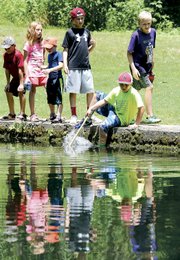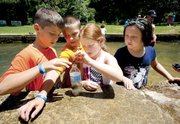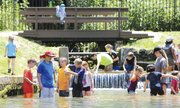Nothing is more refreshing than cold water on a hot summer day.
Crystal clear water for drinking.
Illinois River Watershed Partnership
Illinois River Watershed Partnership art and nature camp
When: July 11-15, July 25-29
Where: Illinois River Watershed Partnership Learning Center in Cave Springs, 221 S. Main St.
Cost: $40 per week, waiting list only
Info: (479) 256-9278 or irwp.org
Ice cold spring water for wading.
Cool lake water for swimming.
No matter the summer activity, if water is involved, look for children to be on board. If education is involved, look for parents to be hooked.
Eight years ago, the Illinois River Watershed Protection, a local conservation group, realized it was in the perfect position to offer the perfect summer activity -- a weeklong art and nature camp for children ages 7 to 12.
The hands-on day camp teaches children -- who come from cities all over Washington and Benton counties -- about the complex watershed in which they live and how the watershed is connected to various ecosystems in the area, said Delia Haak, executive director of Illinois River Watershed Protection.
The camp continues to grow each year, and this year has been the largest, she said.
Between 100 and 120 children have attended two camps at the group's Watershed Sanctuary in Cave Springs. Two more camps are planned, and both have waiting lists.
Camp Activities
"We both like nature," said camper Bella May, 9. She and her brother, Hunter, 7, are attending their first year of camp.
They both agree canoeing on the sanctuary's 6-acre lake and catching crawdads were their favorite parts of camp.
Another first-timer, Baylor Elsea, 7, said fishing and canoeing were his top picks for the week's best fun.
"I just like being outside," Baylor said. "I like nature and the environment stuff that it has that you can play with and that you can climb. You have this huge space to do stuff."
The Watershed Sanctuary is a total of 30 acres -- 24 acres of land and a 6-acre lake -- across the street from the Illinois River Watershed Protection learning center in downtown Cave Springs. The nonprofit group purchased the land in September 2012, and the learning center -- which is a former church -- in 2014.
The campers spend their days both inside the learning center and outside at the sanctuary.
While indoors, the campers study the relationship between art and nature. They use found pieces in nature -- such as twigs, sand or rocks -- with traditional art materials -- such as paint -- to create their own works.
"We made pictures of real animals and not real animals out of (putting) two (animals) together," said Bella of one project.
For another project, Hunter said, "We painted around the twigs to make it look like a tree."
The learning center also houses a children's library and a large space with educational displays.
Outside, the children take nature hikes, canoe, fish, geocache around the lake, monitor water quality, catch crawdads and practice archery.
The sanctuary has two outdoor classroom areas where campers can learn about green infrastructure or the species living in the cave adjacent to the sanctuary. One classroom area is brand new; the North Shore Pavilion was built with grant money from the Arkansas Game & Fish Commission. It sits just north of the lake and is visible from the street. The facility is open to the public or can be rented for private use.
The other outdoor learning area is at the back of the property, where several felled trees provide bench-like seating. Recycling was the educational topic on a recent Thursday.
The center is open daily from 9 a.m. to 4 p.m., while the sanctuary is open from dawn to dusk. Both are free to explore.
Year Round Conservation
The Illinois River Watershed Protection works alongside members of the community throughout the year on conservation projects, Haak said.
The conservation group has recently completed green infrastructure projects -- rain gardens, bioswales, porous pavers, trees -- at five trail heads on the Razorback Greenway.
"The greenway pretty much follows creeks and streams, and the trail heads are often there (nearby)," Haak said. "It's all about improving the water before it reaches the creeks and streams as it flows off of these parking lots or restroom rooftops."
During the recent school year, students at Springdale junior high schools grew hard-to-find native grasses. Students also helped plant those grasses along Spring Creek -- one of the major tributaries of the Illinois River -- at the Lake Springdale trail head.
"You can't just go to the nursery to get (the native grasses)," Haak said. "It's amazing how those native grasses will spread and really slow down (the water)."
Giving students a project during which they can get their hands dirty is more effective and more fun, Haak said. And that's what the camp is doing for the younger children -- teaching them to take care of nature in the area now, so it doesn't become a problem for someone else later.
"We want (the kids) to understand how their actions -- individually and together -- can make a difference," Haak said.
NAN Our Town on 07/07/2016




